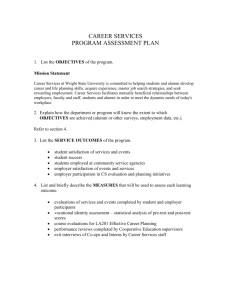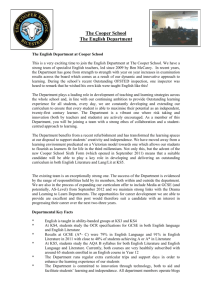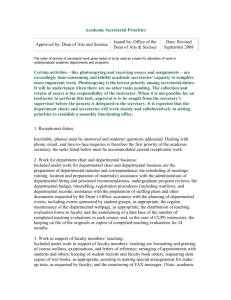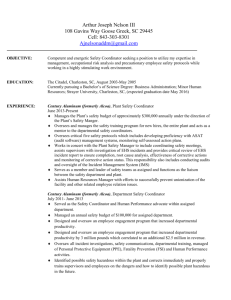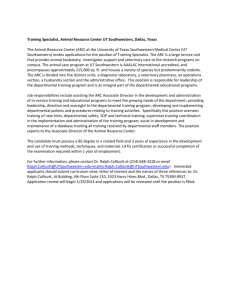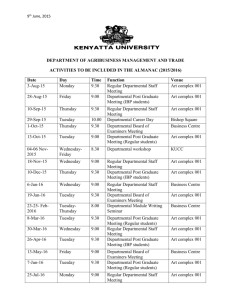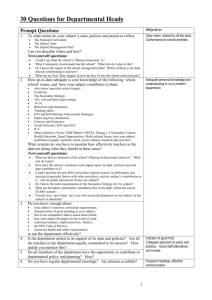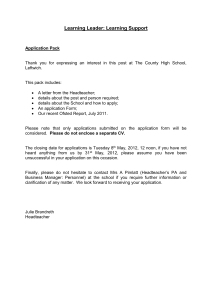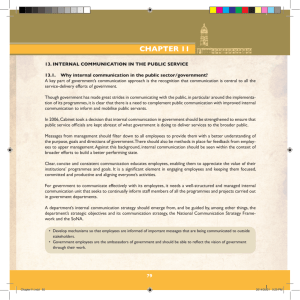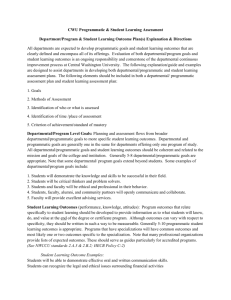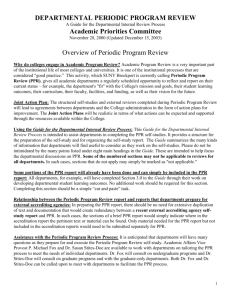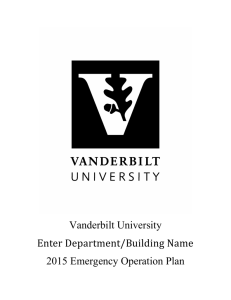Departmental Handbook - What should go in it?
advertisement
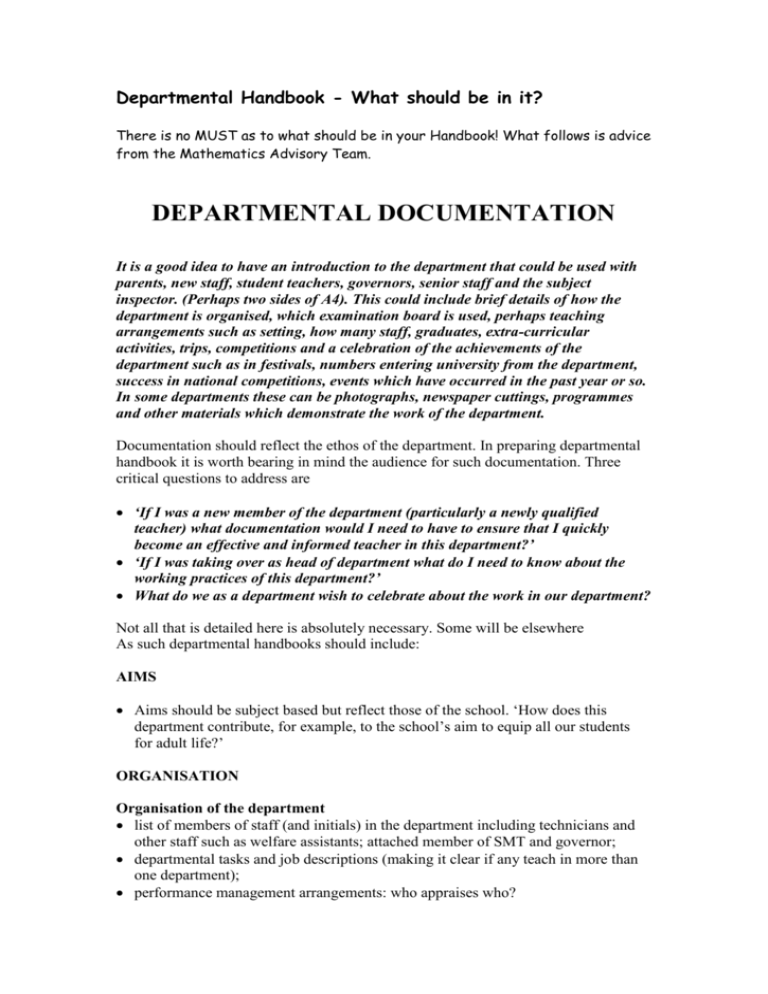
Departmental Handbook - What should be in it? There is no MUST as to what should be in your Handbook! What follows is advice from the Mathematics Advisory Team. DEPARTMENTAL DOCUMENTATION It is a good idea to have an introduction to the department that could be used with parents, new staff, student teachers, governors, senior staff and the subject inspector. (Perhaps two sides of A4). This could include brief details of how the department is organised, which examination board is used, perhaps teaching arrangements such as setting, how many staff, graduates, extra-curricular activities, trips, competitions and a celebration of the achievements of the department such as in festivals, numbers entering university from the department, success in national competitions, events which have occurred in the past year or so. In some departments these can be photographs, newspaper cuttings, programmes and other materials which demonstrate the work of the department. Documentation should reflect the ethos of the department. In preparing departmental handbook it is worth bearing in mind the audience for such documentation. Three critical questions to address are ‘If I was a new member of the department (particularly a newly qualified teacher) what documentation would I need to have to ensure that I quickly become an effective and informed teacher in this department?’ ‘If I was taking over as head of department what do I need to know about the working practices of this department?’ What do we as a department wish to celebrate about the work in our department? Not all that is detailed here is absolutely necessary. Some will be elsewhere As such departmental handbooks should include: AIMS Aims should be subject based but reflect those of the school. ‘How does this department contribute, for example, to the school’s aim to equip all our students for adult life?’ ORGANISATION Organisation of the department list of members of staff (and initials) in the department including technicians and other staff such as welfare assistants; attached member of SMT and governor; departmental tasks and job descriptions (making it clear if any teach in more than one department); performance management arrangements: who appraises who? inset within the department and opportunities beyond. Organisation of teaching groups a department timetable (staff initials, set, room) and setting arrangements with a chart (or list) showing how groups are arranged, who teaches which, whether any are parallel etc. Set (or teaching group) lists showing numbers and gender split. Organisation of the curriculum Outline scheme of work for example, an overview of what is to be covered in each year and by which groups (more detailed schemes of work may be described elsewhere). How is the implementation of the NC secured? is the subject delivered at any other time than timetabled lessons, for example, half or whole days e.g. industry day or RE day? ICT within the subject contribution to pupil’s spiritual, moral, social and cultural development. ADMINISTRATION Ordering equipment procedures; charging policy in department for lost books; use of the photocopier Examination entries Assessment records Report writing procedures: are reports monitored by HOD? Guidance for what is included? Dealing with complaints complaints to the dept. Who do parents contact? What guidance does an NQT have if a parent complains them? POLICIES AND PRACTICES (WHICH DEFINE BEST PRACTICE) Procedures for lessons Lesson structures Practical work (with references to H&S) Procedures for SEN SEN policy for the department and how it ties in with the school’s policy for SEN. Able pupils’ policy? Ensuring equal opportunities Equal opportunities policy - for example, how does the department celebrate cultural diversity? Ensure that its materials promote EO? Assessment and marking policy department portfolios showing standards for moderation of work for KS3/ GCSE/ A level? Homework policy Other policies For example, numeracy, literacy and ICT. How are these used within the department? How do they tie in with the school’s. How do we ensure pupils acquire the technical language in this subject? Policies specific to the department such as calculator use. Display? Use of the school library Rewards and sanctions Department meeting structure MONITORING THE WORK OF THE DEPARTMENT Statement of intent Procedures for monitoring pupil work, quality of teaching, standards how does monitoring of the work of the department take place? Do all staff get involved in monitoring each other? targets? For staff, department. and individual pupils. Exam results, ICT , literacy, numeracy; analysis of examination performance of individual groups (and consequently teachers) and ethnic minority and gender; analysis of numbers choosing subject for options, GCSE and A level? analysis of what happens post A levels. If pupils go to university, how successful are they? Outcomes of monitoring 2000 (1, 2, …) Evaluation of the work of the department 2000 (1, 2, …) including how inset has been used and its effect Previous Ofsted report on the department and the action taken as a result DEVELOPMENT PLAN to include: what is intended, who will be responsible, what the outcomes will be, how will we know we have achieved them, timescale and costs. Linked to school development plan? Implications for staff training. Previous year Review of plan Current plan Department capitation and how it is spent Efficiency of the department DEPARTMENT MINUTES agendas and minutes of all dept. meetings should be put in an appendix. SCHEMES OF WORK . held separately and in more detail than in the overview.
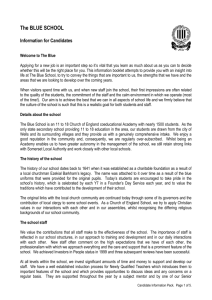


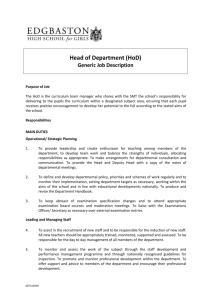
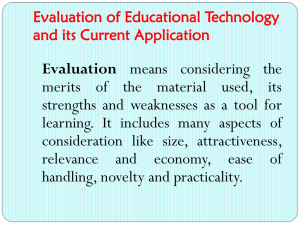
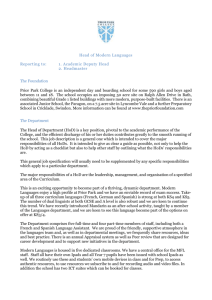


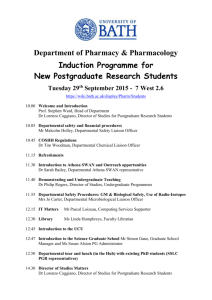
![afl_mat[1]](http://s2.studylib.net/store/data/005387843_1-8371eaaba182de7da429cb4369cd28fc-300x300.png)
